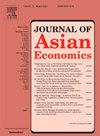从冲突到协调:衡量污染-碳增长协同水平的新框架
IF 3.4
3区 经济学
Q1 ECONOMICS
引用次数: 0
摘要
本文以最优方向为基准,以实际方向与基准的接近度为衡量协同度的原则,提出了一种衡量污染减排与碳减排协同度的新框架。该测量框架同时考虑了实际方向和最优方向,通过余弦函数量化了接近程度,从而直观地呈现了协同水平,有效解决了现有研究主要只关注实际方向的局限性。并根据不同地区的实际发展阶段,提出了差异化的协同方向。在此框架下,本文探讨了中国城市污染与碳减排协同水平的总体特征、演变趋势及影响因素。结果表明,污染与碳减排的协同水平呈波动上升趋势,降低碳强度应是提高协同水平的主要重点。东、中、西部地区在经济高速增长期的协同水平相对较低。通过简单的实证模型分析影响因素,本文发现,提高经济发展水平、推动绿色技术创新、加大政府对生态环境保护的重视是提高污染减排协同水平的有效措施。反之,过高的第二产业比重和较高的经济增长目标会对协同水平产生不利影响。本文章由计算机程序翻译,如有差异,请以英文原文为准。
From conflict to coordination: A new framework to measure the synergy level of pollution-carbon-growth
This paper proposes a new framework for measuring the synergy degree of pollution reduction and carbon mitigation, using the optimal direction as the benchmark and the proximity between the actual direction and this benchmark as the principle for synergy degree measurement. This measurement framework considers both the actual and optimal directions, quantifies the degree of proximity through the cosine function, and thus intuitively presents the synergy level, effectively addressing the limitation of existing research that predominantly focuses on the actual direction alone. Additionally, it offers differentiated synergy directions based on the actual development stages of different regions. Based on this framework, the paper explores the overall characteristics, evolving trends, and influencing factors of the synergy level of pollution and carbon reduction in China's cities. The results show that the synergy level of pollution and carbon reduction exhibits a fluctuating upward trend, and reducing carbon intensity should be the main focus for improving the synergy level. The synergy levels in the eastern, central, and western regions are relatively lower during their respective periods of rapid economic growth. By employing a simple empirical model to analyze the influencing factors, this paper finds that enhancing economic development levels, promoting green technology innovation, and increasing government attention to ecological environment protection are effective measures to improve the synergy level of pollution and carbon reduction. Conversely, an excessively high proportion of secondary industry and higher economic growth targets will adversely affect the synergy level.
求助全文
通过发布文献求助,成功后即可免费获取论文全文。
去求助
来源期刊

Journal of Asian Economics
ECONOMICS-
CiteScore
4.70
自引率
9.40%
发文量
90
期刊介绍:
The Journal of Asian Economics provides a forum for publication of increasingly growing research in Asian economic studies and a unique forum for continental Asian economic studies with focus on (i) special studies in adaptive innovation paradigms in Asian economic regimes, (ii) studies relative to unique dimensions of Asian economic development paradigm, as they are investigated by researchers, (iii) comparative studies of development paradigms in other developing continents, Latin America and Africa, (iv) the emerging new pattern of comparative advantages between Asian countries and the United States and North America.
 求助内容:
求助内容: 应助结果提醒方式:
应助结果提醒方式:


